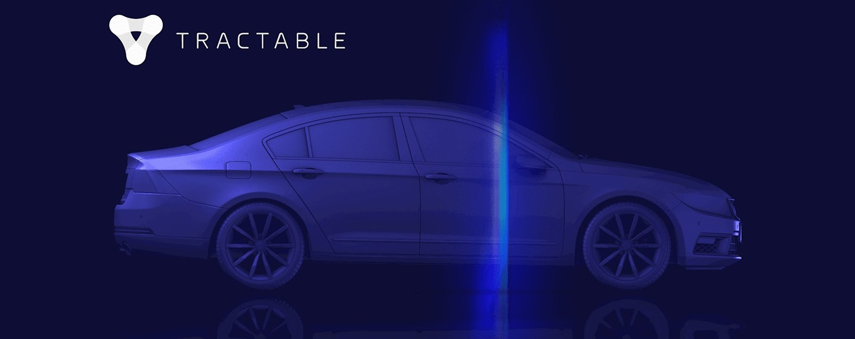How Tractable is revolutionising insurance with AI

Credit: Tractable
What if insurance claims could be made based on data drawing from millions of images? Meet Tractable, the AI company reimagining an industry with technology.
Artificial intelligence is starting to seep into a range of industries. From finance to healthcare, startups and established companies are starting to take a-hold of the technology. Insurance is no different.
Tractable is a startup with artificial intelligence at the centre of what it does: the company uses computer vision to identify accidents that motorists have, using the technology to make categorisation a lot more efficient. It’s because of this efficiency that Tractable is generating a lot of buzz in the insurance industry.
“Computer vision looks at asset damage and predicts repair costs from photos in real-time, just like an expert,” explains Norval Scott. Norval now works for Tractable, as Head of PR and Communications, EMEA. “So claims can be settled faster – in minutes, instead of weeks – and livelihoods restored.”
Just like companies such as Monzo, Tractable is taking full advantage of new technology in order to provide a quicker, more efficient service to its customers.

“Tractable develops artificial intelligence for accident and disaster recovery,” says Norval. “Whenever accidents hit, property is damaged: for example, cars, homes and infrastructure. And every time, you need a visual assessment to assess the damage, unlock the funds, and return lives to normal.”
“Our AI does just this. It uses computer vision to look at asset damage and predicts repair costs from photos in real-time, just like an expert, so claims can be settled faster – in minutes, instead of weeks – and livelihoods restored.”
How does computer vision work?
Any raw visual output that is processed by a machine can be classed as computer vision. This could be something a rudimentary as a ticket scanner or face recognition on your phone.
Just with most face recognition tools, Tractable’s technology uses deep learning, trained on millions of photos. The algorithms learn from these photos to assess and diagnose the damage. However, Tractable’s AI is even able to judge how sure it is of its assessments.
Insurance is an extremely competitive sector. We think AI brings a number of benefits for everyone across the value chain.
Norval Scott, Tractable
“Once photos of damage are uploaded, the tool is, therefore, able to recognise what parts have been damaged and assess how badly they have been affected,” Norval says. “It can then recommend decisions, based on its confidence level. The system’s confidence level will depend on part visibility, photo conditions, and the extent of damage severity.”
“This means the AI can also interact with the person taking photos to request specific additional photos on the spot.”
The great thing about AI is that it is constantly evolving and improving. Tractable’s is no different: Norval says that the company have trained their AI on over 150 million images. “We are constantly training our AI with images to become more experienced over time, like an expert would.”
This means too that there are areas waiting to be explored by Tractable, both within vehicle insurance and aside from it.
Tractable is shaking up the insurance world
Insurance is an industry perhaps not appreciated for technological innovation. By embracing artificial intelligence, however, Tractable has an edge over its rivals.
“Insurance is an extremely competitive sector,” says Norval. “We think AI brings a number of benefits for everyone across the value chain. It obviously helps the insurers, as it greatly accelerates a time-consuming task. It helps the bodyshops, as it helps them process more claims and focus their expertise on what their best at. And it helps the customer, as their vehicles are repaired and returned to the road much more quickly.”

Norval says that the industry is fascinating, not least because of the history behind it. Many of the biggest names in insurance have been around for a long time, making it ripe for innovation.
“Some of the biggest players in [insurance] have literally operated for hundreds of years,” Norval says. “This does mean there are some practices that could be challenged or changed, and some internal resistance to doing so. Insurance isn’t known as being a fast-moving industry, although there are some players capable of moving very quickly. We think our success with those companies will encourage others to also investigate what AI can offer.”
So what’s the reaction been like to Tractable within the industry from some of these more established names?
“It’s been exceptional,” says Norval. “The solution has traction with the world’s leading insurance companies, who are implementing it to improve their service to their customers. We now employ around 100 people, with offices in London, New York and Tokyo, and our clients – who include some of the top 10 largest insurance companies in the world – are employing Tractable in eight countries.”
With the industry taking notice of Tractable, it’s only a matter of time before the business starts to expand further into other realms of insurance. Property damage, for example, is one particular area that could be explored by Tractable’s AI, given that is would use computer vision in much the same way.
The challenge for Tractable moving forward is a refreshing one. There is plenty of interest in their service and the business is thriving on the product that it offers: all that is needed is to expand the AI further, maybe branching off into different types of insurance. After all, Tractable is already a big hit.
“Every single insurance company that has trialled Tractable has gone on to become a customer and there has been no churn in our sales funnel to date,” says Norval. “Our customers love what we provide.”